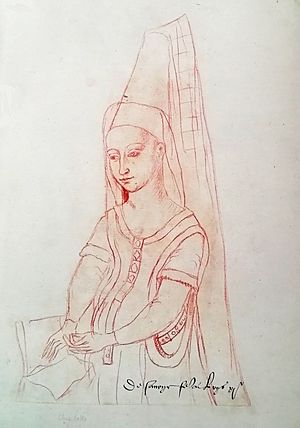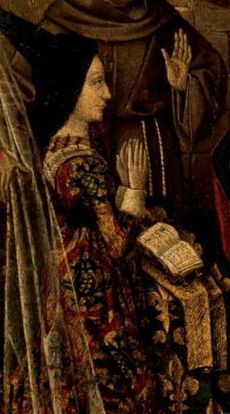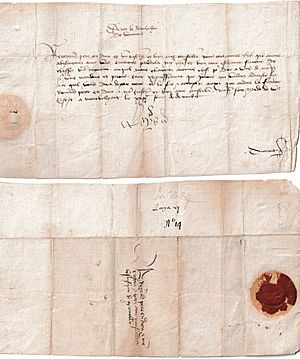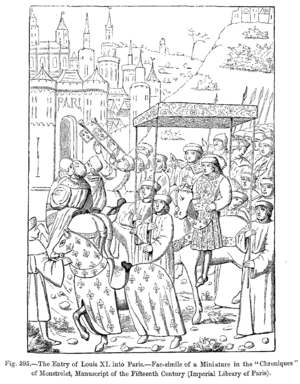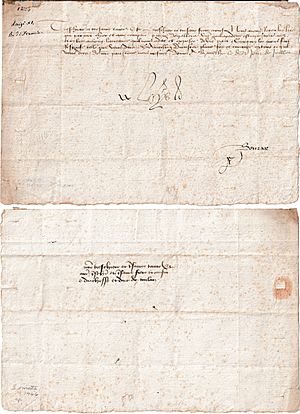Louis XI facts for kids
Quick facts for kids Louis XI |
|
|---|---|
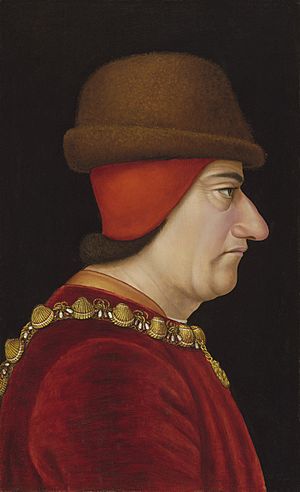
Louis XI wearing his Collar of the Order of Saint Michael, c. 1469
|
|
| King of France (more...) | |
| Reign | 22 July 1461 − 30 August 1483 |
| Coronation | 15 August 1461, Reims |
| Predecessor | Charles VII |
| Successor | Charles VIII |
| Born | 3 July 1423 Bourges, Berry, France |
| Died | 30 August 1483 (aged 60) Château de Plessis-lez-Tours, France |
| Burial | 6 September 1483 Notre-Dame de Cléry Basilica, Cléry-Saint-André |
| Spouse |
Charlotte of Savoy
(m. 1451) |
| Issue Detail |
|
| House | Valois |
| Father | Charles VII of France |
| Mother | Marie of Anjou |
| Signature |  |
Louis XI (born July 3, 1423 – died August 30, 1483) was the King of France from 1461 to 1483. People called him "Louis the Prudent" (French: le Prudent). He became king after his father, Charles VII, passed away.
As a young prince, Louis openly rebelled against his father in 1440. This short uprising was called the Praguerie. His father, King Charles VII, forgave him and put him in charge of the Dauphiné, a region in southeastern France. However, Louis kept plotting, which made his father banish him from the royal court. From the Dauphiné, Louis started his own political group. He even married Charlotte of Savoy against his father's wishes. King Charles VII sent an army to make Louis obey, but Louis escaped to Burgundy. There, he was welcomed by Philip the Good, the Duke of Burgundy, who was a big enemy of King Charles.
When Charles VII died in 1461, Louis left Burgundy to become king. He was known for his clever plans and diplomatic skills. People nicknamed him "the Cunning" (Middle French: le rusé) and "the Universal Spider" (Middle French: l'universelle aragne). His enemies said he was always spinning webs of plots and secrets.
In 1472, the new Duke of Burgundy, Charles the Bold, started a war against Louis. But Louis managed to separate Charles from his English allies. He signed the Treaty of Picquigny (1475) with Edward IV of England. This treaty officially ended the Hundred Years' War. Charles the Bold died in the Battle of Nancy in 1477, and his family line ended. Louis took advantage of this to take over many Burgundian lands, including Burgundy itself and Picardy.
With no major threats from other countries, Louis could focus on France. He stopped rebellious nobles, made the king's power stronger, and helped the country's economy grow. He died on August 30, 1483. His young son, Charles VIII, became the next king.
Contents
Early Life and Challenges
Louis was born in Bourges on July 3, 1423. His father was Charles VII of France, the King of France. At this time, France was in the middle of the Hundred Years' War. The English controlled northern France, including Paris. King Charles VII only ruled the central and southern parts of the country. Louis's grandmother, Yolande of Aragon, was very important in the royal family. She pushed to drive the English out of France when things looked very bad for the French.
Just a few weeks after Louis was christened at the Cathedral of St. Étienne on July 4, 1423, the French army lost badly to the English at the Battle of Cravant. Soon after, English and Burgundian armies even threatened Bourges.
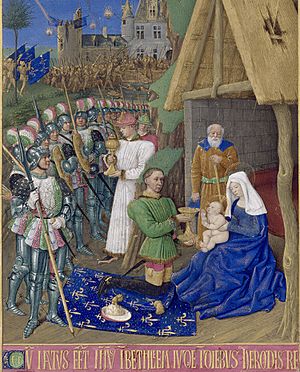
During the time of Louis's grandfather, Charles VI (1380–1422), the Duchy of Burgundy was closely linked to the French throne. But the central government was weak, so all the French duchies acted almost like independent countries. Burgundy had grown very large and powerful. By the time Louis's father, Charles VII, was king, Philip the Good ruled Burgundy. His duchy stretched from the North Sea in the north to the Jura Mountains in the south. It went from the Somme River in the west to the Moselle River in the east. During the Hundred Years' War, the Burgundians sided with England against the French king.
In 1429, young Louis was at Loches when he met Joan of Arc. She had just won her first big victory against the English at the Siege of Orléans. This battle was a turning point for the French in the Hundred Years' War. Joan later led French troops to more victories. Paris was taken back after her death. Louis and his father were able to ride into the city in triumph on November 12, 1437. Even so, Louis grew up knowing that France was still weak. He saw his father as a weak ruler and disliked him for it.
Royal Marriages
On June 24, 1436, Louis met Margaret, the daughter of King James I of Scotland. His father had chosen her as his bride for political reasons. We don't have direct stories from Louis or Margaret about their first meeting. So, we can only guess if they had negative feelings for each other. Some historians believe Louis was set on disliking his wife. But everyone agrees that Louis went through with the wedding dutifully. He even formally hugged Margaret when they first met.
Louis's marriage to Margaret was part of royal diplomacy in the Middle Ages. The French monarchy was in a difficult spot back then. The wedding was simple for the time. It took place in the chapel of the castle of Tours on the afternoon of June 25, 1436. The Archbishop of Reims, Renaud of Chartres, led the ceremony. Louis, at 13, looked more grown-up than his 11-year-old bride. Margaret was said to look like a beautiful doll. Charles VII wore "grey riding pants" and didn't even take off his spurs. The Scottish guests left quickly after the reception. The French royal court was quite poor then. They couldn't afford a fancy ceremony or to host guests for long. But the Scots saw this as an insult to their proud country.
After the wedding, doctors advised against the couple living together as husband and wife. This was because both were still very young. Margaret continued her studies. Louis traveled with his father to loyal parts of the kingdom. Even then, Charles was surprised by his son's intelligence and strong will. During this trip, Charles named Louis the Dauphin of France. This was the traditional title for the king's eldest son. The beautiful and educated Margaret was popular at the French court. But her marriage to Louis was not happy. This was partly because Louis had a difficult relationship with his father-in-law, who was very fond of Margaret. She died without children at age 20 in 1445.
In 1440, Louis, at 16, joined an uprising called the Praguerie. Its goal was to weaken King Charles and make Louis the ruler of France. The uprising failed, and Louis had to give in to the king. Charles chose to forgive him. In this revolt, Louis was influenced by Charles I, Duke of Bourbon. Louis had to go back to Paris, but he was "by no means defeated." In fact, before his final loss, Louis's "military strength, combined with the dislike of the common people for great lords, won him the support of the citizens of Paris." This was a big learning experience for Louis.
Louis kept up his military activities. In 1444, he led an army of "écorcheurs" (groups of mercenary soldiers) against the Swiss. This was at the Battle of St. Jakob an der Birs. He was very impressed by the Swiss army's strength. However, he still argued with his father. His constant plotting, including disrespectful behavior towards his father's beloved mistress Agnès Sorel, led to him being sent away from court. On September 27, 1446, he was ordered to his own region, Dauphiné. He mostly lived in Grenoble. Despite many calls from the king, the two never met again. In Dauphiné, Louis ruled almost like a king. He continued his plots against his father. On February 14, 1451, Louis, who had been a widower for six years, made a clever marriage. He married eight-year-old Charlotte of Savoy without Charles's permission. This marriage would greatly affect France's foreign policy. It marked the start of France's involvement in Italian affairs.
Finally, in August 1456, Charles sent an army to Dauphiné. Louis fled to Burgundy. Duke Philip the Good gave him a safe place to stay in the castle of Genappe. King Charles was furious when Philip refused to hand over Louis. He warned the duke that he was "giving shelter to a fox who will eat his chickens."
Becoming King and Reforms
In 1461, Louis heard that his father was dying. He quickly went to Reims to be crowned. He wanted to make sure his brother, Charles, Duke of Berry, didn't try to take the throne. Louis XI became King of France on July 22, 1461.
Louis worked towards many of the same goals as his father. He wanted to limit the power of the dukes and barons in France. He was much more successful at this. Louis made the tax system more efficient. He removed many of his former friends from power, who thought he would be loyal to them. Instead, he chose talented people from ordinary backgrounds for government jobs. He especially liked those who worked with the great French merchant Jacques Coeur. He also allowed nobles to trade without losing their noble status. He made the government more efficient by changing how offices worked. Louis spent a lot of his time as king traveling. He would visit towns, check on local governments, set up trade fairs, and promote trade rules.
One of Louis XI's most important contributions was creating the royal postal roads in 1464. This system had relays (stops) for the king's messages all over France. This communication network spread across the country. It helped him earn his nickname "Universal Spider" because he had eyes and ears everywhere.
As king, Louis became very careful with money, even though he used to spend a lot. He wore simple clothes and mixed with ordinary people and merchants. A courtier named Philippe de Commines wrote about some of Louis's activities in his memoirs. Louis often surrounded himself with smart advisors from humble beginnings. These included Commines himself, Olivier Le Daim, Louis Tristan L'Hermite, and Jean Balue. Louis wanted to speed up everything and build a new world. Because of all the changes he made to the French government, Louis XI is known as a leading "civil reformer." His changes helped the rising trading and merchant classes in France.
Louis XI also got involved in the Church's affairs in France. In October 1461, Louis ended the Pragmatic Sanction of Bourges. His father had started this in 1438 to create a French Gallican Church that was free from the Pope's control in Rome.
Rivalry with Charles the Bold
Philip III was the Duke of Burgundy when Louis became king. Philip wanted to start a Crusade to the Holy Lands. But he needed money for it. Louis XI gave him 400,000 gold crowns for the Crusade. In return, Louis got several lands, including Picardy and Amiens. However, Philip's son, Charles I, Duke of Burgundy (known as the Count of Charolais then), was angry. He felt he was losing his inheritance. He joined a rebellion called the League of the Public Weal. This rebellion was led by Louis's brother, Charles, the Duke of Berry. The rebels didn't win many battles, but Louis also didn't have much luck. Louis XI fought an undecided battle against the rebels at Montlhéry. He was forced to agree to a peace treaty that wasn't good for him, just to end the fighting.
When the Count of Charolais became Duke of Burgundy in 1467 as Charles I ("the Bold"), he thought about creating his own independent kingdom. But Louis had made the French government so strong that the dukes of Burgundy could no longer act as freely as before. Burgundy also faced many problems and revolts in its own lands. The people of Liège especially fought against the Duke of Burgundy in the Liège Wars. At first, Louis XI allied himself with the people of Liège.
In 1468, Louis and Charles met at Péronne to talk. But during their talks, they learned that the people of Liège had rebelled again. They had killed the Burgundian governor. Charles was furious. Philippe de Commines, who worked for the Duke of Burgundy at the time, had to calm Charles down. They feared he might hit the king. Louis was forced to sign a humiliating treaty. He gave up many lands he had taken from Philip the Good. He also turned against his allies in Liège and promised to help Charles stop the uprising there. Louis then watched as Liège was attacked, and hundreds of people were killed.
However, once Louis was out of Charles's reach, he said the treaty was not valid. He started building up his army. His goal was to destroy Burgundy completely. Nothing bothered Louis's dream of a strong, central monarchy more than a very powerful noble like the Duke of Burgundy. War broke out in 1472. Duke Charles attacked Beauvais and other towns. But these attacks failed. The Siege of Beauvais ended on July 22, 1472, and Charles finally asked for peace. Philippe de Commines then started working for King Louis.
In 1469, Louis created the Order of St. Michael. He probably did this to copy the famous Burgundian Order of the Golden Fleece. That order was founded by Charles's father, Philip the Good. Just like King John II of France had created the now-gone Order of the Star to copy King Edward III of England's Order of the Garter. In both cases, a French king seemed to want to create a special order of chivalry to make the French royal court look more important, following the example of his main enemy.
Dealing with England
| Coin of Louis XI, struck circa 1470 | |
|---|---|
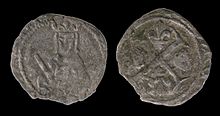 |
|
| Front: Medieval image of Louis XI | Back: Fleurs-de-lis (French royal symbol) |
While France and Burgundy were fighting, England was having its own civil war. This was known as the Wars of the Roses. Louis was interested in this war because Charles the Bold, the Duke of Burgundy, was allied with the Yorkists. The Yorkists were fighting against King Henry VI. When the Earl of Warwick fell out with the Yorkist King Edward IV, Louis gave Warwick a safe place in France. Through Louis's clever diplomacy, Warwick then teamed up with his old enemy Margaret of Anjou. Their goal was to put her husband, Henry VI, back on the throne. The plan worked, and Edward was forced to leave England in 1470. But he returned to England in 1471. Warwick was then killed at the Battle of Barnet in 1471. King Henry VI was murdered soon after.
Now, Edward was the clear ruler of England. He invaded France in 1475. But Louis was able to negotiate the Treaty of Picquigny. This treaty meant the English army would leave France in exchange for a large sum of money. The English gave up their claim to French lands like Normandy. This meant the Hundred Years' War was finally over. Louis boasted that his father had forced the English out with weapons, but he had driven them out with good food and French wine.
End of the Rivalry with Charles the Bold
Just like his father, Louis spent most of his time as king dealing with political fights with the Duke of Burgundy. For this, he used the Swiss army, which was very famous for its strength. He had seen their power himself at the Battle of St. Jakob an der Birs.
War broke out between Charles and the Swiss after he invaded Switzerland. This invasion was a huge mistake. On March 2, 1476, the Swiss attacked and defeated the Burgundians at Grandson. Then, a few months later, on June 22, they won again at Murten. The duke was killed at the Battle of Nancy on January 5, 1477. This event marked the end of the Burgundian Wars.
So, Louis got to see his sworn enemy destroyed. The nobles who still supported the old feudal system (where lords had a lot of power) gave in to his authority. Others, like Jacques d'Armagnac, Duke of Nemours, were executed. The lands that belonged to the Duchy of Burgundy now became part of the French crown.
Connections with Italy
Louis's marriage on February 14, 1451, to the 8-year-old Charlotte of Savoy was the real start of France's involvement in Italy. Italy was a busy and competitive place, ruled by five main powers: Venice, Milan, Florence, the Pope's lands, and the Kingdom of Naples. Besides these five, there were about a dozen smaller states in Italy. These states were always changing their policies and alliances. Genoa and the growing state of Savoy (around Turin) were examples of these smaller powers in northern Italy. Even the Italic League – a group of the five major Italian powers formed after the Treaty of Lodi in 1454 – was constantly changing its internal alliances.
Both Louis XI and his father Charles VII had been too busy fighting Burgundy to pay much attention to Italy. Also, Louis was distracted by disagreements with England and his struggles with Maximilian of Austria. Maximilian married Mary of Burgundy, Charles the Bold's heir, and wanted to keep her lands. However, the death of the Duke of Burgundy in 1477 finally settled Burgundy's place under the French throne. The Treaty of Picquigny with England in 1475 and a peaceful agreement in 1482 about Mary of Burgundy's inheritance finally allowed Louis XI to focus on Italy.
From the Italian states' point of view, the Duke of Burgundy's death in 1477 and the end of his duchy as a threat to France meant big changes. Italy's relationship with France would be different.
Even though he was married into the royal family of Savoy, Louis XI always tried to have a strong relationship with Francesco I Sforza, the Duke of Milan. Milan was a traditional enemy of Savoy. To show how close Milan and the King of France were, Sforza sent his son Galeazzo Maria Sforza with a large army to help Louis XI in his war against the League of Public Weal in 1465. Later, differences came up between France and Milan. Milan then tried to become less dependent on France. But after Burgundy fell in 1477, Milan saw France in a new way. Milan quickly fixed its relationship with Louis XI. Likewise, France's old enemy, King Ferdinand I of Naples, started looking for a marriage alliance between Naples and France. Louis XI also started friendly relations with the Papal States, forgetting that the popes had supported the Duke of Burgundy in the past. In January 1478, he signed a good treaty with the Republic of Venice.
French involvement in Italy would reach new levels with Louis XI's son, Charles VIII. In 1493, Charles answered a call for help from Ludovico Sforza, Francesco Sforza's younger son. This led to an invasion of Italy. This would become a very important moment in Italian history.
Death and Legacy
Louis XI had suffered from strokes and many years of illness. He died on August 30, 1483. He was buried in the Basilica of Notre-Dame de Cléry in Cléry-Saint-André. His wife, Charlotte, died a few months later and is buried with him. Louis XI was followed by his son, Charles VIII, who was thirteen years old. Louis's oldest daughter, Anne, became the regent (ruler in place of the young king) for Charles.
Louis XI's Impact
Louis was eager to get information about his enemies. So, starting in 1464, he created a network of postal relays all over France. This was an early version of the modern French postal service.
Louis helped his kingdom grow by encouraging trade fairs. He also supported building and maintaining roads. Louis XI organized the kingdom of France with the help of officials from the middle class. In some ways, Louis XI created the basic structure of the modern French Government. This structure lasted until the French Revolution. Because of this, Louis XI is seen as one of the first modern kings of France. He helped move France out of the Middle Ages.
Louis XI was very superstitious and kept astrologers around him. He was also interested in science. Once, he pardoned a man who was sentenced to death. But only on the condition that the man would be a test subject for a gallstone operation.
Through wars and clever tricks, Louis XI overcame France's mostly independent feudal lords. By the time he died in the Château de Plessis-lez-Tours, he had united France. He also laid the groundwork for a strong monarchy. However, he was a private and quiet man. Few people truly mourned his death.
Even with Louis XI's political smarts and practical approach, Niccolò Machiavelli criticized him. In his book The Prince, Machiavelli called Louis short-sighted. He said Louis was unwise for getting rid of his own foot soldiers and relying on Swiss mercenaries instead.
Children
Louis and Charlotte of Savoy had these children:
- Louis (October 18, 1458 – 1460)
- Joachim (July 15, 1459 – November 29, 1459)
- Louise (born and died in 1460)
- Anne (April 3, 1461 − November 14, 1522), who married Pierre de Beaujeu
- Joan (April 23, 1464 – February 4, 1505), who married Louis XII, King of France.
- Louis (born and died on December 4, 1466)
- Charles VIII of France (June 30, 1470 – April 8, 1498)
- Francis, Duke of Berry (September 3, 1472 – November 1473)
Images for kids
See also
 In Spanish: Luis XI de Francia para niños
In Spanish: Luis XI de Francia para niños


